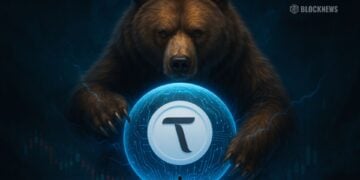- VeChain is an enterprise-focused Layer-1 blockchain with PoA consensus, dual-token economics, and strong IoT integration.
- Partnerships include Walmart China, BMW, and LVMH, with use cases in supply chain, authentication, and sustainability tracking.
- 2025’s Hayabusa phase focuses on developer growth, NFT expansion, and governance engagement, paving the way for 2026 mass adoption goals.
VeChain, the enterprise-first blockchain, has spent nearly a decade building a reputation not on hype, but on substance. From eliminating counterfeit luxury goods to revolutionizing automotive and food supply chains, VeChain has steadily built a case as one of the most utility-driven blockchain platforms in the world. VeChain has the tech, the partnerships, and the momentum. So, let us take a closer look at what makes this beast tick.
What Is VeChain?
VeChain is a Layer-1 smart contract blockchain designed to serve businesses, governments, and developers with scalable, secure, and transparent infrastructure. It was founded in 2015 by Sunny Lu, former CIO of Louis Vuitton China, and Jay Zhang, a former PwC executive. Originally launched on Ethereum under the name VEN, VeChain rebranded and migrated to its own blockchain—VeChainThor—in 2018.
Unlike general-purpose blockchains like Ethereum, VeChain was built with a narrow but powerful focus – solving inefficiencies in supply chain management and enterprise data systems. Its architecture is tailored for real-world integration, offering tools that allow companies to track products, verify authenticity, automate processes, and share data securely across stakeholders.
At its core, VeChain is about trust—trust in data, trust in products, and trust in systems. And it delivers that trust through a combination of blockchain technology, IoT integration, and a unique dual-token economic model.
How Does It Work?
VeChain is powered by a Proof-of-Authority (PoA) consensus mechanism, a model that favors speed, efficiency, and governance over raw decentralization. PoA relies on known, verified validators—Authority Masternodes—that are KYC-verified and entrusted to keep the network secure and functional. This setup allows for high-speed, low-cost transactions and makes VeChain ideal for commercial use.
Transactions are validated by 101 Authority Masternodes, ensuring quick finality and an energy-efficient blockchain with minimal overhead—exactly what corporations demand.
In addition to this, the dual-token system is another cornerstone of VeChain’s architecture. VET is the primary token used for value transfer, staking, and governance. VTHO, on the other hand, is used to pay for transaction fees and smart contract execution. This separation allows VeChain to stabilize network costs, shielding enterprises from the volatility of crypto markets.
What Problems Does It Solve?
VeChain was born out of frustration with the limitations of existing blockchain platforms. Ethereum, for example, lacks a robust governance framework and suffers from unpredictable gas fees. These issues make it unsuitable for large-scale commercial applications.
VeChain solves these problems by offering:
- Stable and predictable transaction costs through its dual-token model
- Scalable infrastructure that can handle high transaction volumes
- Enterprise-grade governance via the VeVote system and Steering Committee
- Real-time data tracking through IoT integration
- Tamper-proof records for supply chains, healthcare, automotive, and more
Overall, in industries plagued by fraud, inefficiency, and opacity, VeChain provides a transparent and immutable ledger that all stakeholders can trust. So, whether it is verifying the authenticity of a luxury handbag, tracing the origin of seafood, or tracking the maintenance history of a vehicle, VeChain brings clarity to complex systems.
Utility and Offerings
VeChain’s utility goes far beyond supply chain tracking. Its ecosystem includes a suite of tools and platforms that cater to a wide range of business needs. This includes:
Meta-Transaction Features
These features empower users and businesses to delegate transaction fees and manage transaction lifecycles. Fee delegation means users do not need to hold crypto to interact with dApps—businesses can sponsor the transaction costs, making user onboarding seamless. This is huge for adoption, especially in consumer-facing industries.
On-Chain Governance
VeChain’s governance model is both centralized and democratic. Governance happens through a Steering Committee and community voting via nodes, including Economic and X-Nodes. Stakeholders actually decide the fate of the network. This ensures alignment of interests and provides a formalized structure for decision-making.
VeChain ToolChain
A low-code blockchain-as-a-service (BaaS) platform that allows businesses to launch apps and services on VeChainThor without needing in-depth blockchain knowledge. It is essentially a toolkit that lets any company, large or small, get blockchain-powered solutions live quickly.
VeUSD Stablecoin
Launched to support DeFi and Web3 projects, VeUSD is a fiat-backed stablecoin that enables low-volatility transactions on the VeChainThor blockchain. It opens the door for lending, borrowing, and other financial services without the risk of price swings.
VeBetterDAO
A newer component of the VeChain ecosystem aimed at growing Web3 community participation and rewarding user activity. VeBetterDAO is focused on gamifying real-world impact—tying blockchain rewards to sustainable behavior. It encourages users and developers to contribute toward eco-conscious and socially valuable goals, further aligning VeChain’s sustainability vision with blockchain incentives.
Ecosystem Highlights
VeChain’s growth has been steady and strategic. The project has built a robust ecosystem through real-world partnerships and institutional interest. This includes:
Luxury and Fashion
VeChain is used by LVMH (parent of Louis Vuitton) to authenticate luxury products. It provides digital certificates tied to each item, protecting against counterfeiting and giving consumers a new level of confidence.
Food Safety
Used by Walmart China to trace food from farm to shelf. The blockchain tracks environmental conditions, origin, and logistics—all verified and logged on-chain for end-consumer transparency.
Automotive
VeChain enables car manufacturers like BMW to store vehicle data, part origins, and service records on-chain. This gives vehicles a digital passport, improving safety, resale transparency, and insurance accuracy.
Sustainability
VeChain is pushing ESG use cases, offering sustainability tracking for carbon emissions, energy usage, and ethical sourcing. Its low energy footprint and eco-friendly vision set it apart from bloated competitors.
Enterprise Adoption
VeChain has partnered with global giants like Walmart China, BMW, Renault, LVMH, PwC, and DNV GL. These collaborations span food safety, automotive data, luxury goods authentication, and sustainability tracking.
Institutional Support
VeChain has received investment and strategic backing from firms like Boston Consulting Group. These relationships have helped VeChain integrate into traditional business ecosystems and expand its reach.
Government Engagement
Municipal governments in China and other regions have explored VeChain for document authentication and public service optimization. This signals growing trust in VeChain’s infrastructure for civic applications.
Roadmap and Plans Ahead
VeChain has launched a bold, multi-phase strategy to expand globally, attract developers, and deepen enterprise adoption. Its vision is structured through a thematic roadmap divided into three distinct phases — Galactica, Hayabusa, and Intergalactica — each serving a unique role in shaping VeChain into a global digital infrastructure for real-world use cases.
Galactica
This foundational phase focused on reinforcing VeChain’s core technology. The phase was successfully completed with the mainnet upgrade on July 1, 2025 (Block #22084200). Key achievements include the introduction of dynamic gas fee markets, 100% base-fee VTHO burning, EVM Shanghai compatibility, and typed transactions. It also brought improvements to ToolChain, meta-transaction features (MPP, DaaS), and the launch of VeUSD, establishing the infrastructure needed for scalable enterprise and developer use.
Hayabusa
Currently underway in Q3 2025, Hayabusa accelerates ecosystem activation. It focuses on attracting developers through hackathons, grants, and upgraded tooling. Full deployment of VeBetterDAO is central to this phase, aiming to drive user engagement via gamified governance. Additional milestones include the rollout of NFT 2.0 with real-world use cases, improved interoperability, and a delegator-validator model to enhance consensus. The mainnet deployment is expected in Q4 2025 after stakeholder voting.
Intergalactica
Beginning in 2026, this final phase targets mass adoption. It aims to simplify user experience, expand VeUSD utility in DeFi, grow enterprise adoption in new regions, and integrate ESG applications via VeBetterDAO. Infrastructure upgrades like JSON-RPC support, cross-chain functionality, and the evolution of VeWorld into a super-app will position VeChain as a backbone for the next era of digital transformation.
Final Thoughts
In conclusion, VeChain has matured into one of the most utility-focused blockchain platforms in the space, backed by real-world adoption, strong enterprise partnerships, and a clear technological vision. And with its roadmap progressing steadily and the ecosystem gaining traction, VeChain is evolving from a niche enterprise solution into a global digital infrastructure. So, as it enters the final phase of its strategic rollout, it will be interesting to see how far its real-world utility can push mainstream blockchain adoption.














